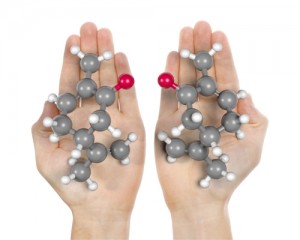Part 18: Finding Pure Essential Oils

Two chiral forms of the constituent carvone. The left enantiomer is found in dill and caraway while the form on the right is found in spearmint essential oil.
Following GC analysis, we run the essential oil through a mass spectrometry instrument (MS) to get an even greater separation and can find up to another 25 to 75 minor compounds. Then with the optical refractometer, we can measure the rotation of the molecules, which helps to identify if they are natural or synthetic.
Like the “library” on the MS instrument, there is a library of well known chiral (the “ch” is pronounced with a hard “k” sound: “ki-ral”) markers for essential oil compounds. These compounds will have determined chirality,which means a left enantiomer or a right enantiomer orientation.
To see the perfect example of “chirality,” bring your hands up, palms facing you. They are mirror images but exactly opposite. They are different in that you cannot put a right-handed glove on your left hand. The term used to identify rotating to the right is dextrorotary, or “d,” and rotating to the left, levorotary, or “l.” (NOTE: The “d” and “l” enantiomers are NOT like the “d” form of a natural vitamin and the “dl” form of a synthetic vitamin.)
We use an optical refractometer to identify the optical rotation of molecules. If the “d” or “l” form deviates from what is in the “library,” the essential oil will be sent either to Dr. Casabianca or to our laboratory for further chiral column testing. The chiral column testing is more detailed and will identify a marker that reveals a synthetic origin. That oil would then be rejected.
To be continued . . .


Would you like to share your thoughts?
Your email address will not be published. Required fields are marked *